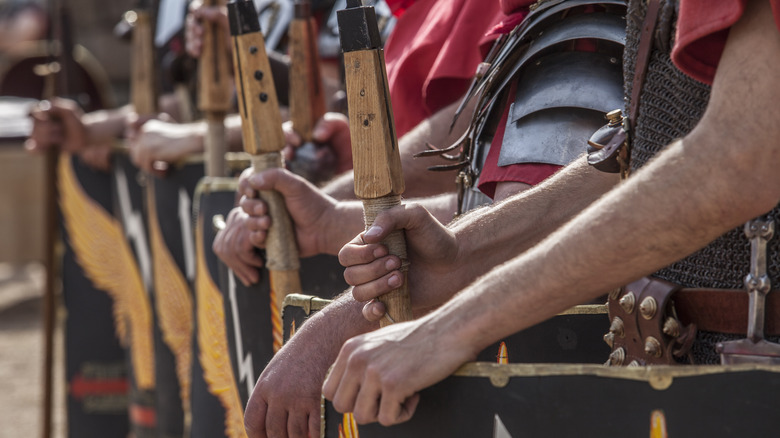Hopscotch Is Older Than You Realize
Hopscotch is possibly one of the only times when an adult will stand back, watch some children deface property, smile and say, "Oh, isn't it so precious?" But it's okay because all that colored chalk just washes off. The kids are having fun learning how to count at the same time as they're learning physical coordination: throw a rock, jump on one leg, then two legs, one leg, etc. It's time-tested, quick and easy to set up, universally understood, fosters teamwork, can incorporate artistry via drawings and colors, and bonus: maybe some Roman soldiers did it 2,000 years ago. Wouldn't that be fun to tell your little tyke as she's hopping around on numbered squares? "Hey there sweetheart! Did you know that some ancient, vicious soldiers did this for physical training to help them slaughter their foes on the field of battle? Yeah, I know! 'Wow' is right!"
Ok, at least we think that Roman soldiers played hopscotch. I mean, they couldn't play "Call of Duty: Maximus Gladius," right? As the story goes and sites like Dale's Countryside Museum explain, Roman soldiers jumped along a series of squares 100 feet long. And, they did so in full body armor, which is way more challenging and way less fun than the modern kiddie version (but an option for ambitious children). In fact, the University at Albany states that the Roman soldier hopscotch training courses were more like American football players doing tire exercises. Since then, hopscotch evolved and spread across the globe.
Legionnaire fitness turned children's game
Ok, so maybe ancient Roman soldiers weren't playing hopscotch, but they were doing some athletic exercise that resembled hopscotch and possibly gave rise to hopscotch in its modern form over a long period of 2,000 years. As the University at Albany explains, some copycat kids liked how this whole jumping on squares thing looked, drew a version of it in miniature form for themselves, and bam: instant children's entertainment for thousands of years. As a very highfalutin 1886 article from The Journal of the Anthropological Institute of Great Britain and Ireland published on JSTOR says (best read in a voice like Saruman's from "Lord of the Rings"), "Many innocent-looking children's games conceal strange survivals of past ages and pagan times."
By this version of hopscotch's origins — which might have originally been "hop-score" — the colossal reach of the Roman Empire in ancient times might be the cause of hopscotch's spread throughout regions far removed from each other, like modern Finland and Spain, or Italy and Scotland. The first time we know of hopscotch written in print — or, Hop-Scotch — comes from 1667's Poor Robin's Almanac, a strange book of compiled, trivia-like facts that would have been excellent for pre-industrial "Jeopardy!" players. If the word "hopscotch" didn't show up in writing before then, that's because noblemen and clergymen hundreds of years ago spent their time writing about kings, wars, and God, not games that little kids were playing in the backyard.
A worldwide, universal game
It really is the case that hopscotch is played the world over. The University at Albany says that hopscotch goes by "hinkelbaan" in the Netherlands, "templehupfen" in Germany, "rayuela" in Argentina, "pico" in Vietnam, "ekaria dukaria" in India, and "marelles" in France. The English name hopscotch is a neologism built from "hop" and the Old French word "escocher," meaning "to cut," from where English gets the word "scratch." This indicates that the English term "hopscotch" arose following the Norman Conquest of England in 1066 C.E., which granted modern English its 30% French-derived vocabulary.
Of course, just because modern hopscotch has a handful of simple rules, uses 10 squares, can be played with one or more people, etc., doesn't mean it was always like this. We're sure that the game has changed quite a bit over time, no matter how similar it is across the globe now. We're also extra, extra sure that way before ancient Roman soldiers used a version of hopscotch-like training to get in shape for conquest and glory, kids and adults worldwide were jumping around and playing games of similar types since the dawn of humanity.
In fact, even though the Roman soldier hopscotch hypothesis predominates discussions of the game's origins, the aforementioned 1886 article from The Journal of the Anthropological Institute of Great Britain and Ireland additionally suggests that the game might originally be astrological in origin, where stepping through its squares resembles stepping through the signs of the zodiac.


